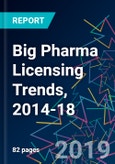Big Pharma deal-making volume and value peaked in 2015, and fell slightly in 2016–18
Between 2014 and 2018, Big Pharma companies signed a total of more than 1,450 drug-focused deals, growing at a compound annual growth rate of 3%. Deal volume jumped 24% from 2014 to 2015, but dropped 6% in 2016, and remained relatively flat in 2017 and 2018.
Seven Big Pharma dealmakers inked more than 100 deals apiece (in- and out-licensing combined) during the five-year period, collectively signing 920 deals
AstraZeneca was the top Big Pharma dealmaker, with 169 alliances. The company also led in out-licensing volume with 66 deals. Johnson & Johnson was second behind AstraZeneca in total deals, followed by Roche.
The rate of Big Pharma's in-licensing activity outpaced out-licensing
Big Pharma companies signed two to three times as many in-licensing agreements as out-licensing deals annually between 2014 and 2018. Out-licensing peaked in 2015 (98 deals) and again in 2017 (100 deals).
Oncology, neurology, and endocrine, metabolic, and genetic disorders (EM&GD) were the top three therapeutic areas for Big Pharma in-licensing
Approximately 45% of Big Pharma in-licensing involved oncology drugs, including a significant portion in the immuno-oncology field. Nearly a third of Big Pharma out-licensing focused on oncology as well. Neurology comprised 11% of all in-licensing deals. The category had five deals with potential values greater than $1bn, led by Teva’s deal to in-license fasinumab from Regeneron, worth $2.6bn.
During the five-year period, payment metrics on all in-licensing deals diverged
Total deal values gradually increased between 2014 and 2018; however, upfront deal values remained generally flat over the five-year period. In 2014 and 2017, upfront values took off considerably thanks to several outlier deals; the $4.5bn and $3.5bn in upfronts in those years, respectively, represented nearly half of all upfronts made during 2014–18. Merck spent the most money on in-licensing over the five-year period, paying out more than $3.3bn in total upfront value.
Big Pharma balanced its in-licensing efforts for drugs across all development phases, but preclinical candidates led
For deals where the phase was disclosed, in-licenses for preclinical candidates topped the list in terms of volume and total deal value over the five-year period. The proportion of Phase III deals shrank considerably, while Phase II alliances decreased through 2016 but rebounded in 2017 and 2018. This trend may be a result of the scarcity of Phase III assets as well as the valuations those later-stage drug candidates can command.
Most Big Pharma alliances covered rights in select regions across the major markets
Regional deals made up 32% of the total Big Pharma in-licensing deals, compared with 30% that were conducted for rights just in North America, followed by worldwide deals at 23%. The proportion of worldwide rights fell relatively steadily from 2014 to 2018, albeit slowly. Global rights deals continue to comprise more than a fifth of all in-licensing deals by Big Pharma.
Big Pharma companies continued to structure most in-licensing deals with an R&D component
Over the five-year period, 62% (639 of 1,021) of in-licensing deals included development or co-development, and 55% (539 of 1,021) involved research and discovery. Big Pharma out-licensing also involved collaborative deal structures, including development/co-development, commercialization, and research/discovery. However, straight licensing led the overall out-licensing group. Co-development/development deal structures consistently led in proportion across the early-stage phases. As deals move to later stages, including Phase III and marketed drugs, the structures of the agreements change to include more acquisition and commercialization components.








